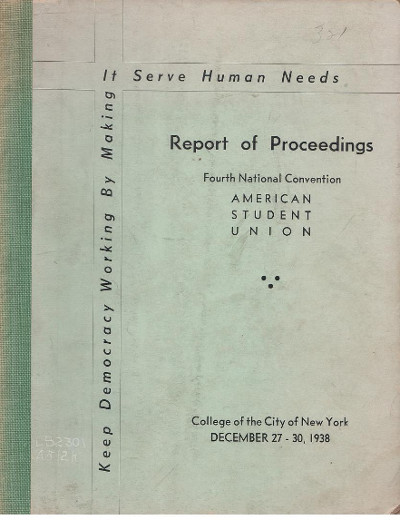
History: In October 1936, a chapter of the American Student Union (ASU) formed at Duke University led by students - Sheldon Harte ('37) and Everett Burtt. Students in the Duke ASU chapter were primarily interested in bringing attention to and discussing problems on campus related to topics of war and peace; academic freedom; labor issues in the nation, in Durham, and on campus; international political conditions; and problems of general student welfare. While membership of the group was small, the organization had an active presence on campus.
Activities: Duke ASU members traveled to Washington DC as delegates to petition Congress for the passing of the American Youth Act (AYA). The AYA sought to expand existing New Deal support for federal funding for American youth. The organization was also very involved in organizing the Peace Conference held at Duke in the spring of 1937 and a campus debate on the issue of cheating. In addition, the Duke ASU brought in a number of speakers to campus to address a range of topics from anti-fascism to labor issues and sponsored art exhibits on these themes in the Woman's College Library (now Lilly Library). The group disbanded, or at least vanished from mention in The Chronicle, after March of 1938.
Notable Members: While at Duke, Sheldon Harte, co-founder of the Duke ASU chapter, also wrote and served as editor for the literary magazine, The Archive. One of his plays, "Red is Symbolic of Kay," included some overt Communist themes. This apparently ruffled the feathers of the University administration and prompted Dean Wannamaker to ask a literature professor to speak to Harte about the appropriateness of the piece.1 After graduating in 1937, Harte became a Communist and served as a bodyguard for Leon Trosky in Mexico City where he was murdered in May 1940.
Nationwide: The ASU was a national anti-war and anti-fascist student organization formed in 1935 and active on US college campuses through 1939. Major issues that the organization advocated for included: promoting racial equality, demanding Reserve Officers' Training Corps (ROTC) be optional, supporting the Oxford Pledge (anti-war pledge), and advocating for educational support for low-income youth. At its height, the organization had 20,000 members and was the largest student activist organization in US history.2
1. Boohner Bridget, "Death of and Idealist," Duke Alumni Magazine, Vol. 77.2, December 1990-January 1991, p. 49.
2. Cohen, Robert, "Student Movements, 1930s," Encyclopedia of the American Left (New York: Oxford University Press, 1998), edited by Mari Jo Buhle, Paul Buhle, and Dan Georgakas, p. 799-802.
